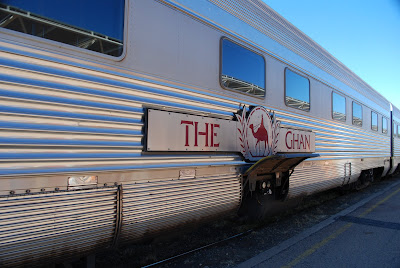
Around about a century or so ago, the Australians decided to procure help with their problems crossing the Outback overland--they enlisted (that is, imported) camels and camel drivers from the high deserts of Afghanistan. Eventually, those camel caravans established regular overland service from the southern port of Adelaide right up over the "red centre" through Alice Springs and on up to the "top end," terminating at the monsoonal northern port of Darwin, which was named for a little-known British naturalist, Charles Darwin, who popped by in a Beagle during the 1830s. The Afghani-inspired camel route became known, with characteristic Aussie fondness for severe abbreviations (see also "barbies," "pokies," and "Oz") as "the Ghan."
Eighty years ago, a railway was completed along the route from Adelaide as far as Alice Springs. Until after the turn of the millenium, this constituted the rail version of the Ghan. Three years ago, the Great Southern Railway finally finished the South-North passenger train route all the way to Darwin and has since been cashing in on our nostalgia for great rail journeys.

Never mind the fact that this particular rail journey, a true rarity in that it spends the better part of three days crossing an entire continent from top to bottom, is really a recent innovation, not a part of old railway lore from the days of Agatha Christie whodunits--it's still a great ride. It's an especially great trip in a sleeper car.


The thing about a long, long, long train ride is this: it is unlike a transoceanic boat trip or a jet plane hop, in that there really is a view outside the windows, but one's experience of that view is utterly unlike the experience of a view from an automobile window because it changes of its own accord, whether one pays attention to it or not. The result is hypnotizing--every time we looked up, a different perspective on the red heart of the Australian Outback presented itself.

And at dawn, both dawns that is, we were fortunate enough to wake up facing westward, so that we saw the full moon brooding over the slowly growing glow of morning. (Mark could not help but be reminded of the fragmentary poem, "El Hombre," by fellow New Jerseyan William Carlos Williams, even if this was the moon and not a star that shone "alone in the sunrise" toward which it gave no part.)

And on the third day, we got off the train for a few hours at Katherine, where we went for a paddle up the eponymous river nearby, recently flooded. Only now receding at the start of "The Dry," the Katherine's banks and surrounding tree trunks were still painted brown with caked mud for meters above the current waterline, while the lower branches were visited by "friendly" freshwater crocs, the higher branches by crows, hawks, and cockatoos--and the occasional stray uprooted tree left by the floods as horizontal debris in the canopy.

No comments:
Post a Comment